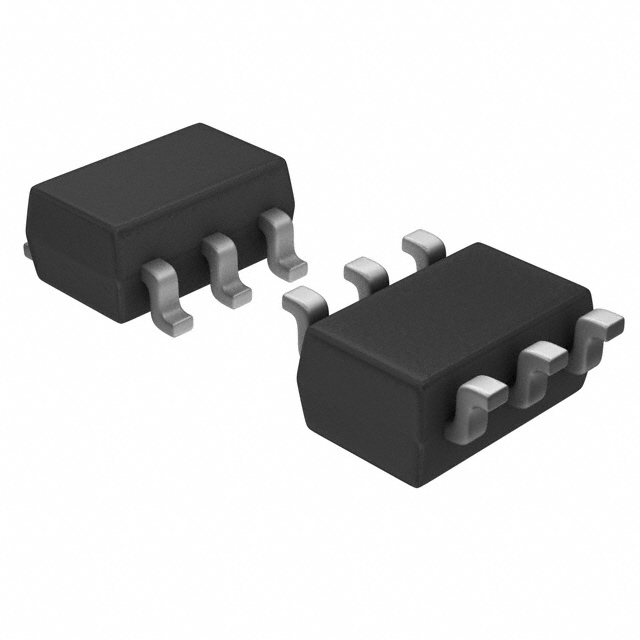Viz Specifikace pro podrobnosti o produktu.

UCC28703DBVT
Product Overview
Category
UCC28703DBVT belongs to the category of integrated circuits (ICs) used in power management applications.
Use
This IC is primarily used for controlling and regulating power in various electronic devices and systems.
Characteristics
- High efficiency: UCC28703DBVT is designed to maximize power conversion efficiency, reducing energy losses.
- Wide input voltage range: It can operate with a wide range of input voltages, making it suitable for diverse applications.
- Compact package: The IC is available in a small SOT-23 package, enabling space-saving designs.
- Low standby power consumption: UCC28703DBVT minimizes standby power consumption, enhancing overall energy efficiency.
Package and Quantity
UCC28703DBVT is packaged in a SOT-23-6 package. It is typically sold in reels containing a specified quantity of ICs.
Specifications
- Input Voltage Range: 4.5V to 30V
- Output Voltage Range: 0.8V to 28V
- Maximum Output Current: 1A
- Switching Frequency: 100kHz to 2MHz
- Operating Temperature Range: -40°C to 125°C
Pin Configuration
The UCC28703DBVT IC has six pins arranged as follows:
____
VDD| |GND
EN | |FB
VIN| |SW
|____|
Pin descriptions: - VDD: Power supply pin for the IC. - GND: Ground reference pin. - EN: Enable pin for turning the IC on or off. - FB: Feedback pin for voltage regulation. - VIN: Input voltage pin. - SW: Switching node pin for power transfer.
Functional Features
- High Efficiency: UCC28703DBVT incorporates advanced control algorithms and low-loss components to achieve high power conversion efficiency.
- Soft Start: The IC includes a soft-start feature that gradually ramps up the output voltage, reducing inrush current and stress on the system.
- Overcurrent Protection: UCC28703DBVT has built-in overcurrent protection to safeguard against excessive load currents.
- Frequency Dithering: This feature minimizes electromagnetic interference (EMI) by spreading the switching frequency spectrum.
- Cycle-by-Cycle Current Limit: The IC monitors the current flowing through the power switch and limits it on a cycle-by-cycle basis, ensuring safe operation.
Advantages and Disadvantages
Advantages
- High efficiency leads to reduced power losses.
- Wide input voltage range enables versatile applications.
- Compact package allows for space-saving designs.
- Low standby power consumption enhances energy efficiency.
Disadvantages
- Limited maximum output current of 1A may not be suitable for high-power applications.
- Operating temperature range may restrict usage in extreme environments.
Working Principles
UCC28703DBVT operates as a flyback controller, regulating the power transfer from the input to the output. It utilizes a feedback mechanism to maintain a stable output voltage. By controlling the switching of the power switch, the IC adjusts the duty cycle to regulate the output voltage within the desired range.
Application Field Plans
UCC28703DBVT finds application in various fields, including: 1. Power adapters for consumer electronics. 2. LED lighting systems. 3. Industrial power supplies. 4. Battery chargers. 5. Automotive electronics.
Alternative Models
Some alternative models that can be considered as alternatives to UCC28703DBVT are: 1. TPS54332DBVR 2. LM2576T-ADJ 3. LT1370CR#PBF 4. MAX668EUB 5. FAN7601B
These models offer similar functionality and can be used as substitutes depending on specific requirements.
In conclusion, UCC28703DBVT is a highly efficient power management IC with a wide input voltage range. Its compact package and low standby power consumption make it suitable for various applications. However, its limited maximum output current and operating temperature range should be considered when selecting this IC for specific projects.
Seznam 10 běžných otázek a odpovědí souvisejících s aplikací UCC28703DBVT v technických řešeních
Sure! Here are 10 common questions and answers related to the application of UCC28703DBVT in technical solutions:
Q: What is UCC28703DBVT? A: UCC28703DBVT is a highly integrated primary-side regulated (PSR) flyback controller used in offline AC/DC power supplies.
Q: What are the key features of UCC28703DBVT? A: The key features of UCC28703DBVT include primary-side regulation, high efficiency, low standby power consumption, and comprehensive protection features.
Q: How does UCC28703DBVT achieve primary-side regulation? A: UCC28703DBVT uses a proprietary constant on-time control scheme that enables accurate output voltage regulation without the need for an optocoupler or secondary-side feedback circuitry.
Q: What is the maximum input voltage supported by UCC28703DBVT? A: UCC28703DBVT can support input voltages ranging from 85VAC to 265VAC.
Q: Can UCC28703DBVT be used in both isolated and non-isolated applications? A: Yes, UCC28703DBVT can be used in both isolated and non-isolated applications, making it versatile for various power supply designs.
Q: Does UCC28703DBVT have built-in protection features? A: Yes, UCC28703DBVT incorporates comprehensive protection features such as overvoltage protection (OVP), overcurrent protection (OCP), and thermal shutdown.
Q: What is the typical efficiency of UCC28703DBVT? A: UCC28703DBVT offers high efficiency, typically above 90%, which helps reduce power losses and improve overall system performance.
Q: Can UCC28703DBVT support power factor correction (PFC)? A: No, UCC28703DBVT does not include power factor correction functionality. It is primarily designed for flyback converter topologies.
Q: What are the typical applications of UCC28703DBVT? A: UCC28703DBVT is commonly used in applications such as USB chargers, adapters, auxiliary power supplies, and small appliances.
Q: Is UCC28703DBVT RoHS compliant? A: Yes, UCC28703DBVT is RoHS compliant, ensuring it meets the environmental standards for hazardous substance restrictions.
Please note that these answers are general and may vary depending on specific design considerations and requirements.

